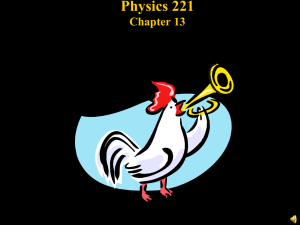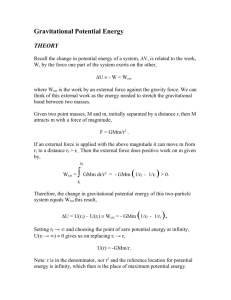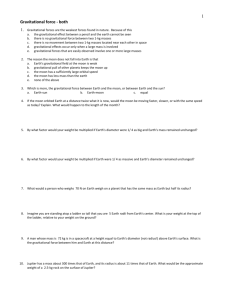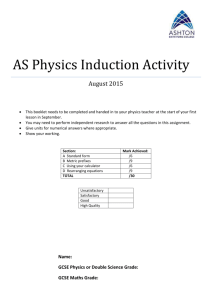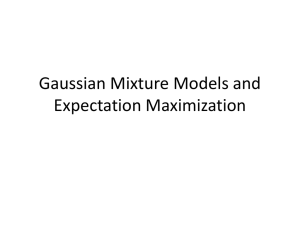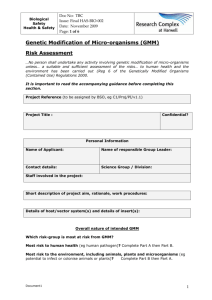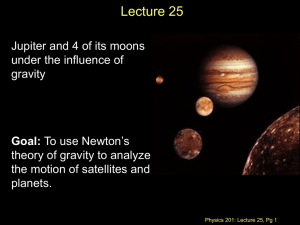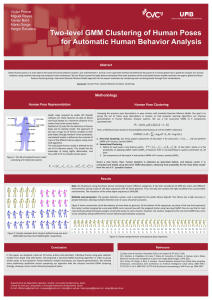Answer Section HW 3 1. 4.1 m/s2, 52° north of east 2. 1.8 m/s2 3. 56
advertisement
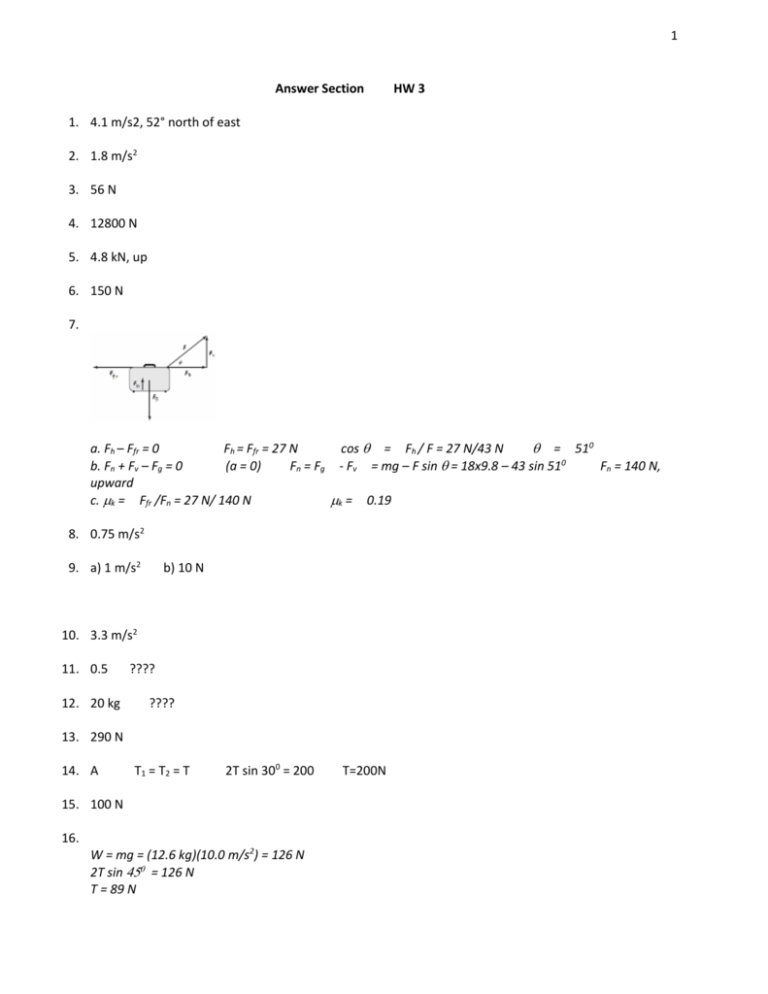
1 Answer Section HW 3 1. 4.1 m/s2, 52° north of east 2. 1.8 m/s2 3. 56 N 4. 12800 N 5. 4.8 kN, up 6. 150 N 7. a. Fh – Ffr = 0 Fh = Ffr = 27 N cos = Fh / F = 27 N/43 N = 510 b. Fn + Fv – Fg = 0 (a = 0) Fn = Fg - Fv = mg – F sin = 18x9.8 – 43 sin 510 Fn = 140 N, upward c.k = Ffr /Fn = 27 N/ 140 N k = 0.19 8. 0.75 m/s2 9. a) 1 m/s2 b) 10 N 10. 3.3 m/s2 11. 0.5 12. 20 kg ???? ???? 13. 290 N 14. A T1 = T2 = T 2T sin 300 = 200 15. 100 N 16. W = mg = (12.6 kg)(10.0 m/s2) = 126 N 2T sin = 126 N T = 89 N T=200N 2 17. 23N m/s2 18. 4.90 5.1 m/s2 19. a= x=41.6 m 20. 2.4 m/s2 21. 6.5 kg Fn = mg cos = 532 N Ffr = Fn = 27 N Fd = mg sin = 373N Fnet = 346 N d = ½ at2 = 12.9 m WOW v = at = 11.7 m/s 22. W = mg = 650 N Fnet = Fd – Ffr a = Fnet/m = 5.32 m/s2 23. Fn = mg cos = 8160 N Ffr = Fn = 408 N Fd = mg sin = 3804N Fnet = 4356 N d = ½ at2 t = 6.43 s v = at = 31.1 m/s W = mg = 9000 N Fnet = Fd – Ffr a = Fnet/m = 4.84 m/s2 24. 0.69 m/s2, down 27. 8 N GRAVITATIONAL FORCE 1. E 2. C 3. A 4. If the moon orbited Earth at twice its present distance, the gravitational attraction between Earth and moon would be one fourth as much. Because of this reduced attraction, the speed of the moon required to maintain a circular orbit would be less (its present speed with less gravity would overshoot a circle, making an elliptical orbit). Because it would be moving more slowly and also because it would have more distance to cover, the length of the month would increase. 5. m: my mass M: otherwise the Earth would orbit the Moon not the Sun Earth mass r: Earth radius – distance from me and Earth F = GmM/r2 Fnew = GmM/(0.25r)2 = 16 GmM/r2 = 16 F the force is 16 times greater 6. F = GmM/r2 Fnew = Gm(0.25)M/r2 = ¼ GmM/r2 =¼ F the force is 4 times smaller (1/ 4) F = GmM/r2 7. Fnew = GmM/(0.5r)2 = 4 GmM/r2 =4F W = 4 x 70 = 8. F = GmM/r2 Fnew = GmM/(5r)2 = (1/25)GmM/r2 = (1/25) F 9. F = GmM/r2 Fnew = GmM/(3r)2 = (1/9) GmM/r2 = (1/9) W 10. F = GmM/r2 Fnew = Gm(300)M/(11r)2 = = 11. (300/121) GmM/r2 (1/25) W = (1/9)(72)(9.8) = 80 N = (300/121) mg = (300/121)(2.5)(9.8) 61 N g = GM/r2 gnew = GM/(1.1r)2 = (1/1.21) GM/r2 = (1/1.21)g 280 N = 8.1 N/kg = 8.1 m/s2 3 12. g = GmM/r2 gnew = GM/(9 r)2 = (1/81) GM/r2 = (1/81) g = 0.1 N/kg = 0.1 m/s2 1 13. F = GmM/r2 14. F = Gm,m2/r2 = (6.67 X10-11 Nm2/kg2)(1 kg)(6 x1024 kg)I(6.4 X 106 rn)2 = 9.77 N (or rounded, 9.8 N) 15. F = Gm1m2/(2r)2 = 9.8 N/4 = 2.44 N (or 2.45 N) 16. F = Gm,m2/r2 =2.0x1020 N 17. m1(2m2)/(2r)2 = ½ 18. W = m1m2/(2r)2 = ¼ 19. F = Gm,m2/r2 Fnew = Gm,m2/(1/10r)2 = 100 Gm,m2/r2 = 100 F 20. F = Gm,m2/r2 Fnew = G(2m,)(2m2 )/(2r)2 = 21. g = GMIr2 = 9.24 N/kg = 9.24 m/s2 22. Fnew = GmM/( 3 r)2 = 9 GmM/r2 = 9 mg 9 times greater as much as much G 4m,m2/4r2 = 9.24/9.8 = 0.94 or 94% g = GM/r2 = 3 m/s2, so M gr2IG = 3(2 X 105)2 ÷ (6.67 x10-11 ) = 1.8 x 1021 kg F the force is 100 times greater the force is unchanged
